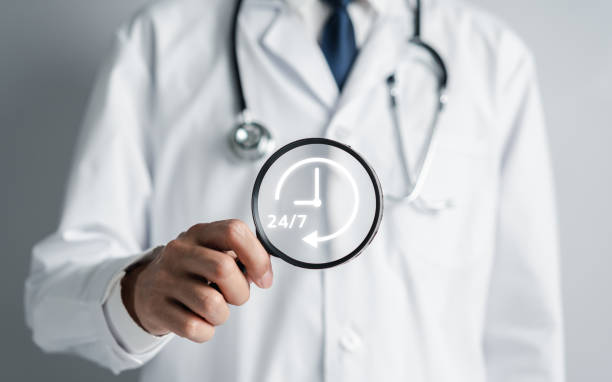In any emergency, every situation seems very difficult. It is not known whether a person will be able to save his life in difficult times or not. Due to lack of information, doctors can worry in emergencies if data is scarce. In this case, it is important for a person to make arrangements well in advance to get out of this problem. Keeping such factors in mind, man has invented some things that help in accidents and other difficult situations. Such things can assess human health in a very short time. And these things have made a lot of progress in the world where there are diseases. Today, such a time has come that the health of a patient can be assessed with small bracelets, smart watches, and patches.
The Critical Role of Time in Emergencies
In emergency medicine, time is not just valuable it’s vital. Medical experts often refer to the “golden hour,” the crucial first 60 minutes following a traumatic event. During this window, prompt intervention significantly increases survival rates. But effective treatment depends on having the right information at the right time.
Knowing a patient’s allergies, chronic conditions, or current medications can completely change how emergency teams respond. For instance, administering the wrong drug to someone allergic to a specific medication can cause severe complications. Similarly, knowing whether a patient has diabetes, heart disease, or a pacemaker helps guide treatment decisions instantly.
Yet, in many emergency situations, patients are unconscious, disoriented, or unable to communicate. Even family members might not know every critical medical detail. This information gap can delay care, forcing responders to rely on guesswork when precision is crucial. That’s why new tools that enable instant medical access through digital databases, wearable technology, and smart health tags are reshaping emergency care standards.
Barriers to Immediate Medical Access
Despite technological progress, barriers to instant medical access persist across healthcare systems. One major issue is the fragmentation of medical data. Patients often receive care from multiple providers, resulting in records scattered across clinics, hospitals, and digital platforms. This lack of unified data access can slow response times during emergencies.
Communication barriers further complicate matters. Language differences, unconscious patients, and missing documentation can prevent responders from obtaining critical medical history. In disaster situations or accidents involving multiple victims, these gaps become even more pronounced.
That’s why healthcare innovators are turning to simple yet powerful tools that make essential medical data instantly retrievable. For example, a Durable QR medical sticker placed on a wearable device or ID card can store or link to vital health details. When scanned by a smartphone, it immediately reveals the patient’s allergies, chronic illnesses, blood type, and emergency contacts. Unlike traditional documents, these stickers are water-resistant, heat-tolerant, and long-lasting, making them reliable in high-stress or unpredictable conditions. They offer a bridge between physical identification and digital information, allowing first responders to act faster and more confidently when time matters most.
Technology Bridging the Gap
Modern healthcare increasingly relies on innovation to overcome long-standing barriers, and instant medical access is no exception. QR codes, mobile health applications, and cloud-based records are transforming how patient data is shared and accessed.
Hospitals are adopting secure digital systems that allow authorized personnel to retrieve patient histories within seconds. Meanwhile, wearable technologies such as smart bracelets, NFC-enabled tags, and health-tracking watches give users direct control over their medical data. These devices allow quick scanning or syncing, making health information instantly available when needed.
Real-world examples highlight their impact. Consider a car accident victim wearing a medical bracelet embedded with a scannable code. Paramedics can scan it on the spot, accessing critical data like allergies, medications, and past surgeries. Instead of waiting for hospital records, treatment begins immediately, potentially saving the patient’s life.
Such technologies are also valuable in non-emergency settings. For chronic patients who need continuous care, real-time access to health information helps doctors monitor treatment progress and adjust medications safely. This connectivity strengthens the bond between patients and providers while enhancing overall healthcare efficiency.
Benefits of Instant Medical Access
The advantages of instant medical access extend far beyond speed alone. The most significant benefit is accuracy. When doctors and paramedics can instantly access verified medical data, they reduce the likelihood of medical errors a leading cause of preventable harm worldwide.
Instant access also improves communication. Emergency teams, hospitals, and families can coordinate better when they share real-time information. This seamless flow minimizes confusion and ensures everyone involved in a patient’s care works with the same up-to-date data.
From a patient’s perspective, the benefits are just as meaningful. Having their medical data readily accessible offers peace of mind. People living with conditions like epilepsy, asthma, or heart disease often worry about being unable to communicate in emergencies. Instant medical access ensures their critical details are always available, even when they cannot speak for themselves.
Healthcare systems also gain from this efficiency. Faster diagnosis and treatment reduce emergency room congestion and allow resources to be used more effectively. It’s a win-win situation for both patients and provider fewer delays, fewer mistakes, and more lives saved.
The Future of Instant Healthcare Access
As digital health technologies continue evolving, instant medical access will become even more integrated and intelligent. Future systems are expected to merge wearable health devices, artificial intelligence (AI), and the Internet of Things (IoT) into a unified ecosystem.
Imagine a world where a patient’s smartwatch not only tracks heart rate but also communicates with emergency networks during a cardiac event. The device could automatically share vital signs and medical history with nearby responders, ensuring immediate and informed care. Such advancements could redefine the very concept of emergency response.
AI-driven predictive analytics could further enhance this ecosystem. By analyzing health trends and prior data, AI systems might anticipate emergencies before they occur. For example, detecting irregular heart rhythms could trigger automatic alerts to caregivers, allowing preemptive intervention.
Moreover, healthcare systems are increasingly prioritizing interoperability the seamless exchange of data between platforms and institutions. Governments and organizations worldwide are working toward standards that ensure data privacy while promoting accessibility. These steps are crucial to building trust and encouraging public adoption of digital medical access technologies.
In the future, durable and secure wearable identifiers will likely become standard components of personal healthcare. Combined with cloud-based medical records, they will ensure that no patient is ever unidentified and no emergency goes uninformed.
Conclusion
When seconds matter, information saves lives. Instant medical access transforms chaotic, uncertain moments into coordinated, data-driven actions. It empowers healthcare professionals to make faster, safer, and more effective decisions while giving patients confidence that their vital information is always within reach.
Technologies like QR code wearables, mobile health platforms, and secure data networks are not just innovations they are life-saving tools. By removing barriers to information, they redefine what’s possible in emergency care.
As healthcare becomes more connected, the focus must remain on accessibility, security, and patient empowerment. Every second counts, and every bit of information matters. In those critical moments when time is running out, having instant access to medical data doesn’t just make a difference it can save a life.



